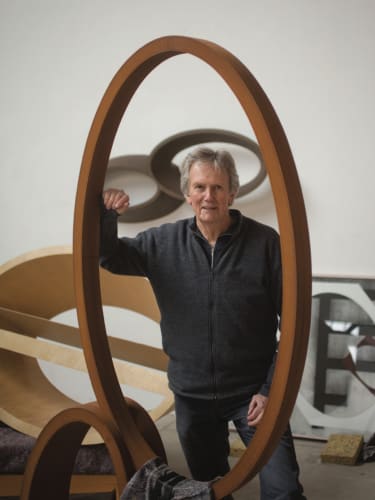British artist Nigel Hall (born 1943 in Bristol) grew up in the Gloucestershire countryside. He studied at West of England College of Art from 1960 to 1964 and went on to the Royal College of Art from 1964 to 1967. A Harkness Fellowship in 1967 took him to United States for two years, choosing California as his base to experience both the city of Los Angeles and the Mojave Desert.
From 1971 to 1981 Nigel was a lecturer and external examiner at the Royal College of Art, London, and ran the MA sculpture course at Chelsea College of Art and Design. In 1995 he won the Pollock-Krasner Award and in 2001 he had a residency at Chretzeturm, Stein Am Rhein, Switzerland. In 2002 Nigel was awarded the Jack Goldhill Sculpture Prize and a year later he was elected a Royal Academician. In 2017 he was given an Honorary Doctorate from University of the Arts, London.
Some years ago, Hall embarked on Southern Shade, a series of sculptures inspired by the south of France. He has been fascinated by the striking umbrella-shaped crowns of the pine trees, the myriad shapes of their branches, and the play of light and shade among them that creates elliptical shapes in varying dimensions. Hall transforms these shapes into spacious vessels filled with light, or else full of darkness. He is drawn to sculpture for its potential to produce spatial experiences. He says of his three-dimensional works that they open the view, not unlike a landscape where the sky is visible through the trees. Setting the space in motion, the walker’s gaze again comes into play.
Hall not only creates sculptures but also monochrome and colour drawings. Forming an autonomous part of his work rather than sketches for his sculptures, they allow him to explore the issue of perception on a smaller scale. The artist compares his works on paper with the small plot of a Japanese garden in which the clever use of perspective creates the optical illusion of a space that is far larger than the garden’s actual dimensions.
Some of Hall’s drawings feature shapes and forms, applied in gouache: deep yellows, blacks and reds. Also visible, and adding a rough and unfinished touch, are some sketchy charcoal lines and smudges that hint at the actual manual work involved. The charcoal articulates the pictorial space, adding shadows or aureoles to the apparent flawlessness of the forms in colour, and bringing another, less clearly defined dimension to these drawings.
The elliptical forms that dominate Hall’s sculptural works and drawings allude to the artist’s walk-honed perception that all is mutable and finite. Reflecting his own views of landscapes and spaces, they allude to the fact that circular shapes appear as ellipses in perspectival distortion as we move past them.
Since Hall's first solo show at Galerie Givaudan Paris in 1967, he has had over 100 solo and over 300 group exhibitions around the world. Solo shows include the Kunsthalle Mannheim 2004, a major retrospective at Yorkshire Sculpture Park 2008 and The Royal Academy, London 2011. In 2020 he exhibited in South Korea at Mo J Gallery and in 2021 he had a solo show at Annely Juda Fine Art Gallery in London.
Hall is well represented in numerous public collections including Tate Gallery, London, MoMA, New York, the Art Institute of Chicago, the British Museum in London, the Los Angeles County Museum, Musée National d’Art Moderne in Paris and Tokyo Metropolitan Museum of Art.
Many of his sculptures are viewable in public spaces around London, Cambridge and Yorkshire.
Nigel Hall lives and works in London.
